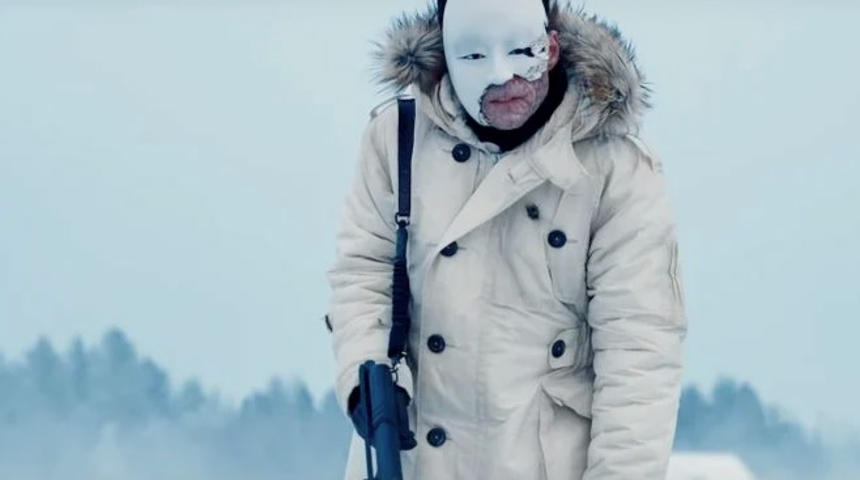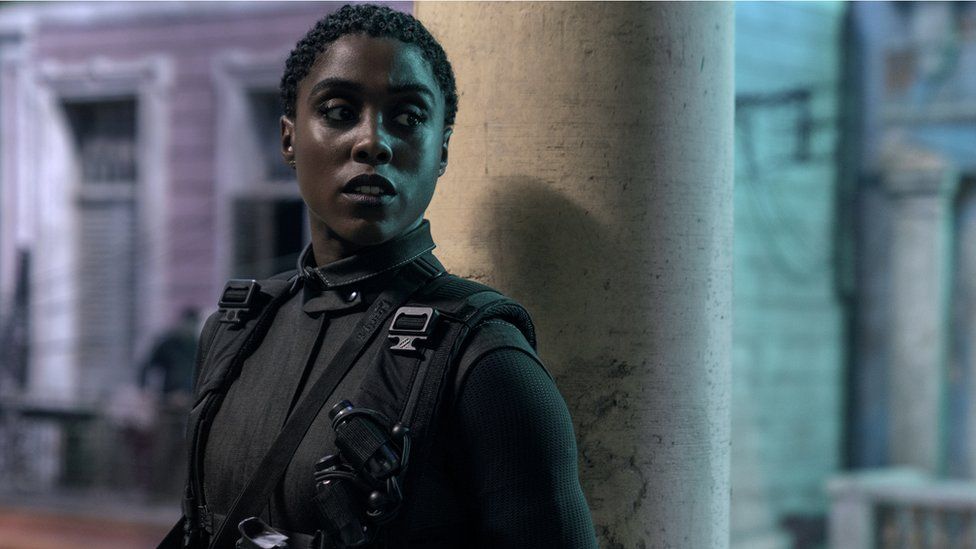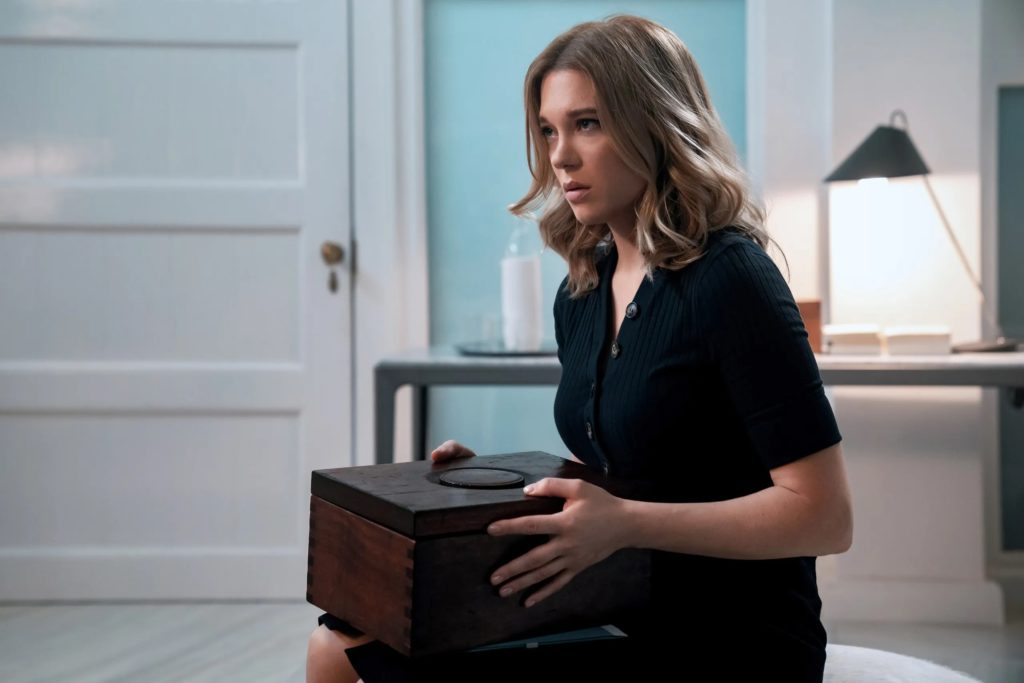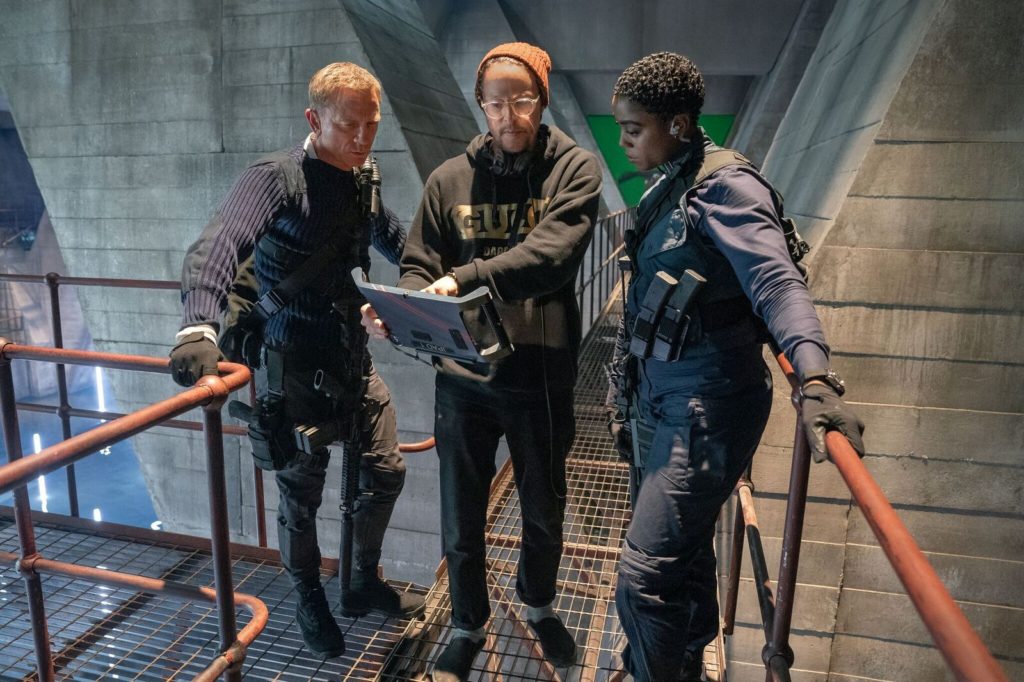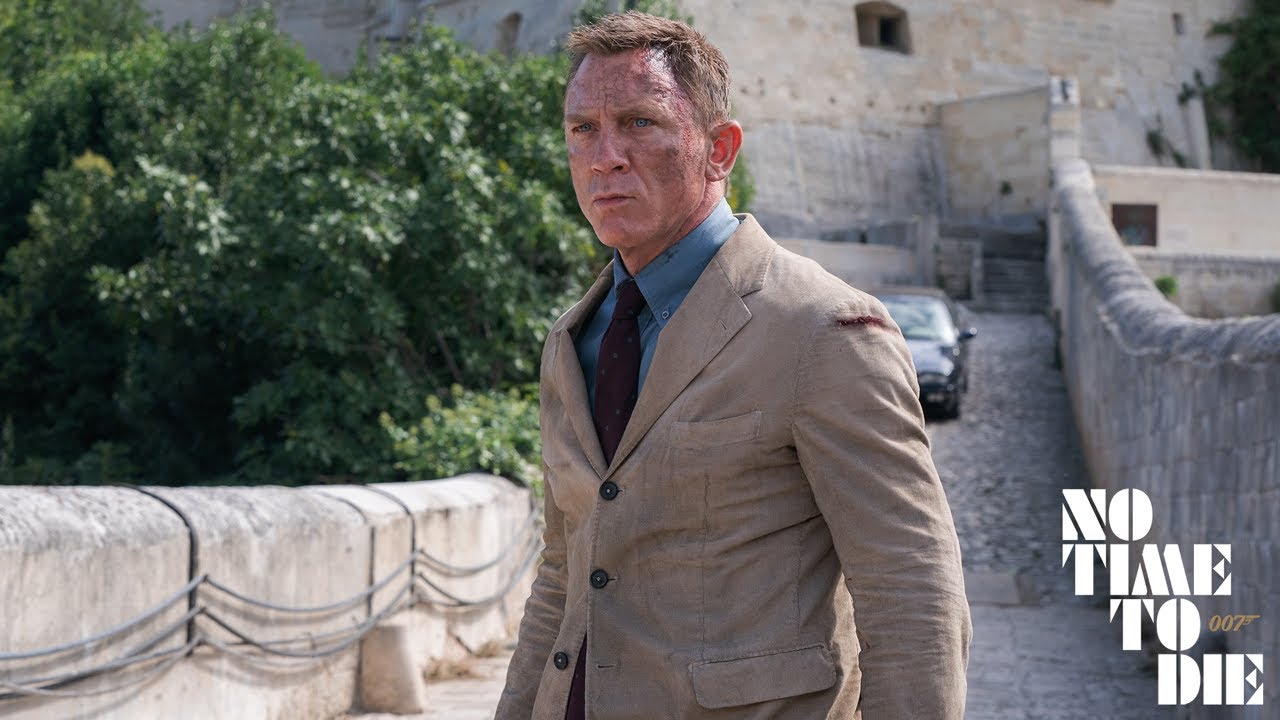詹姆斯-邦德系列的最新作品被命名为《无暇赴死》;在25部电影之后,这位英国的神秘特工仍然在这里,曾经它只是伊恩·弗莱明创作的间谍小说的银幕改编,现在则是一个有望将电影院从流媒体的魔爪中拯救出来,并推动电影业在Covid之后复苏的救星。除此之外,这也是丹尼尔-克雷格(Daniel Craig)扮演的007的卸任之作,五部电影将邦德带到现代世界,但充其量也是不均衡的,如果这还不够,它还应该在这部电影里创造一个全新的自成一体的冒险。要做的事情太多,所以确实没有时间去死,因为这些任务里任何一个失败都是灾难性的。所有这些相互冲突的利益在这部电影的163分钟内发生碰撞,最终大部分都设法实现了这些期望,尽管并不总是以最优雅、精确或令人满意的方式。
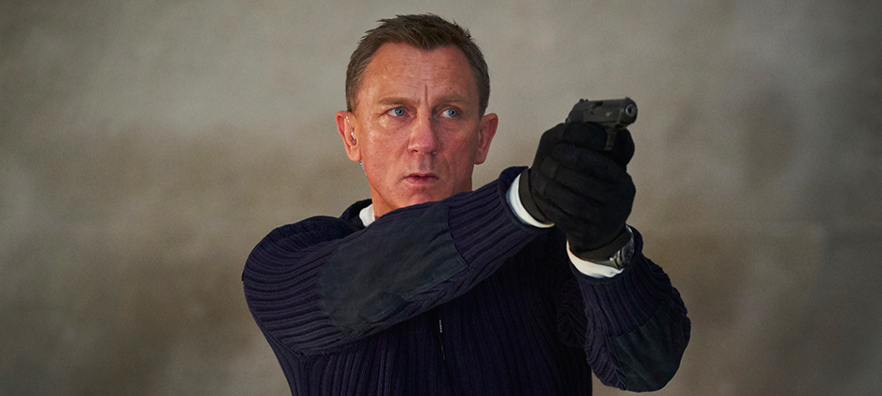
《无暇赴死》从幽灵的离开开始,这在以前的邦德电影中是不可想象的(只有部分演员从一部电影到另一部电影,没有任何迹象表明他们还记得之前的拯救世界的冒险),但在丹尼尔-克雷格的电影中这却变得很常见。《007大破量子危机》是《007大战皇家赌场》的续篇,《007:大破天幕杀机》试图带回一些经典的邦德元素,而《007:幽灵党》则是一次失败的尝试,它从叙事上重构了每一部电影,这就使得情节看起来总是由克里斯托弗·瓦尔兹扮演的布洛费在暗中操纵。因此,我们就不难理解《无暇赴死》承接了之前的故事:邦德与他在《幽灵党》中的爱人玛德琳-斯万(Lea Seydoux饰演)在意大利城市马泰拉享受着一个美妙的假期,然而,和平并没有持续很久;当邦德去看望过去的爱侣薇丝朋·琳德的坟墓时,暴力来袭,他在《皇家赌场》中遭受背叛的幽灵又回来了,使他的新的感情关系变得复杂。如今,不仅詹姆斯-邦德有背景故事,而且邦女郎也有黑暗的过去。这段过去与拉米·马雷克(Rami Malek)扮演的沉闷、自恋的大反派萨芬(Safin)有关,他的计划涉及一种终结世界的科技生物武器,这看起来似乎同样乏味,但在影片中的不同阶段却得到了很好的利用。
当人们想到邦德电影时,通常首先想到的是以著名的开枪镜头开场的序幕,即邦德走在侧面,旋转着向屏幕射击。除此之外,影片通常以一个很酷的动作戏开场,其中动人心魄的插曲也为整部电影奠定了气氛。该系列电影之间最大的区别是汽车、女孩和反派,其他的东西总是保持不变。而且,最重要的是,他们并没有真的要结束什么。邦德电影是由自成一体的小任务组成,从不涉及持久的个人利害关系,每部电影是由使其独特的小变化而变得与众不同(例如,在《黄金眼》中使用宝马而不是阿斯顿-马丁)。但是,丹尼尔-克雷格时代是在恐怖主义和由受折磨的反英雄领导的动作片之后开始的,规则发生了变化,允许采用更接地气的严肃方式。冒着淡化邦德精髓的风险,《皇家赌场》仍然是一部丰满精彩的电影,至今仍给人以特别的感觉。创造一个更有戏剧性的角色增加了叙事的风险,并为该系列电影带来了一个非常特殊的问题:开始一个角色意味着你最终必须结束它。
这也是《幽灵党》令人失望的原因,因为它没有给克雷格的角色带来一个合适的结局。而这也是《无暇赴死》既被过去五部电影所累,但又有机会让我们的英雄陷入真正的情感和共鸣中的原因,这在以前是没有过的。从缺点来看,《无暇赴死》是缓慢的、木讷的;没有什么行动,大量重复相同的基本情感。大多数角色都是单调的: Lea Seydoux一直在悲伤和心碎, Lashana Lynch在电影中作为新的00号特工显得很酷,而Rami Malek说话时带着俄罗斯口音,表现得像打了大量镇静剂。该片边拍边写,一直到最后,剧本明显缺乏精确性,这已不是什么秘密。
《无暇赴死》的主要优势在于其主要明星丹尼尔-克雷格。凯瑞·福永(Cary Fukunaga)是第一位接手邦德系列电影的美国导演,他非常了解这项任务,因为他抛开了所有必要的东西,围绕克雷格打造了一部阴森、忧郁的电影。影片沐浴在黑暗的色彩和橙色的夕阳中,并给了主要演员几个沉思的特写镜头。在这部电影中,什么都没有发生,但危险却无处不在。我们看到的邦德毫不畏惧地审视自己的缺陷,处理他留下的暴力和破坏的痕迹。丹尼尔-克雷格比我们在《幽灵》中看到的更有说服力地投入到这个角色中。在这里,他在扮演军情六处特工时,对多种语气的掌控非常自信,从内省到自嘲再到阳刚之气,你会觉得他才是真正的詹姆斯-邦德,而Pierce Brosnan或Roger Moore等演员只是冒牌货。当影片进行到最后一幕时,你会在25部电影中第一次为邦德感到害怕,这正是因为克雷格为这个角色注入了悲剧性的潜台词;邦德已经从风流倜傥的花花公子变成了自我牺牲的英雄,一个能够将他人置于自己之上的人。这是一个真正的角色拱门。
在近3个小时观影结束的时刻,我们会觉得《无暇赴死》是以2006年《皇家赌场》为开端的这一系列的一个合适的结局,但一个重要的问题仍然存在:这还是一部007电影吗?这的确是一部努力寻找自己身份的电影,因为它不再是一部有趣的冷战间谍片,但也不能只是回到15年前的911事件后的世界。由于被迫对过去进行反思,《无暇赴死》拥有着多重身份,有时看上去是一部愚蠢的老式致敬片,有时则成为一部超现代的大片,感觉更像是美国片而不是英国片(电影摄影让人想起Denis Villeneuve的缓慢、有条不紊的方法,而Hans Zimmer的配乐也无助于将影片与这种美学分开)。最终,《无暇赴死》选择了自己的方向,一个前所未有的方向。尽管有缺陷,但这是詹姆斯-邦德电影的一个历史时刻,而且是令人感觉危险的时刻。这个五部系列电影以自己的方式结束,并永远地改变了这个秘密特工,目前还不清楚这种反常在15年后,即下一个担任邦德角色的演员退休后,是否会显得过时或革命性,但可以肯定的是,该系列电影的未来从未如此不确定过。可以说,《无暇赴死》打破了詹姆斯-邦德的理念,不管是好是坏,无论下一个人是谁,都必须打下坚实的基础,以新的身份将这位特工推向21世纪中期。
影评人简介

贝尔纳多·莱特(Bernardo Leyte),常驻巴黎的电影制作人。 他在西班牙、德国和英国长大,毕业于伦敦电影学院,目前担任导演。 他是一位充满热情的影迷,他所观看的电影囊括各种类型,从他的偶像斯坦利·库布里克(Stanley Kubrick)和安德烈·塔可夫斯基(Andrei Tarkovsky)的電影,到超级英雄、恐怖片、动漫等。
Original text
The latest entry in the James Bond saga is aptly titled No Time to Die; after 25 films, the English secret agent is still here, and what was once just a screen adaptation of Ian Fleming’s spy novels is now a franchise that is expected to save cinema from the clutches of streaming and to boost the film industry’s recovery after the Covid-19 pandemic. On top of that, it is also the end of Daniel Craig’s tenure as 007, five films that have updated Bond into the modern world but have been uneven at best. And if that wasn’t enough, it is also supposed to create a whole new self-contained adventure within the runtime of this film. There’s too much to do and so there is no time to die indeed, as a failure in any of these departments would be catastrophic. All of these – sometimes conflicting- interests collide within 163 minutes of a bloated film that ultimately mostly manages to fulfil every one of those expectations, though not always in the most elegant, precise or satisfying way.
No Time to Die begins right where Spectre left off, something that was unthinkable in the films of the previous Bond actors (where only some of the cast would remain from film to film without any indication that they remembered the previous world-saving adventure) but has become commonplace during Daniel Craig’s run: Quantum of Solace was a direct sequel to Casino Royale, Skyfall tried to bring back some measure of classic Bond elements, and Spectre was a failed attempt to narratively retcon every film and make it look like it was always Blofeld, the man in the shadows played by Christoph Waltz, who was pulling the strings. It should come as no surprise then, that the story now continues with Bond enjoying a well-deserved holiday in the Italian city of Matera with his love interest from Spectre, Madeleine Swann, played by Lea Seydoux. However, peace doesn’t last long; when Bond visits the grave of past love interest Vesper Lynd, violence comes knocking , and the ghost of the betrayal he suffered in Casino Royale returns, complicating his new relationship. Nowadays, not only does James Bond have a backstory, but the Bond girls also have a dark past. This past may be connected to the dull, narcissistic villain Safin, played with clichéd darkness by Rami Malek. His plans involve a world-ending technological bioweapon, which may seem equally dull, but is put to good use at different times in the film.
When one thinks of what makes a Bond film a Bond film, the first things that usually come to mind are the beginnings. There is the famous gun barrel sequence, where Bond walks in profile and spins to shoot the screen, of course. There is an action packed cold-open . And there is a luxurious credits sequence with a song that sets the mood for the whole film. The biggest differences between each films are the cars, the girls and the villain. Everything else always remained frozen, immune to change. And, most importantly, they didn’t really have to end anything. Bond films are historically self-contained little missions that never deal with lasting personal stakes, and they are defined by the small changes that make them unique (for example, using a BMW instead of an Aston Martin in Golden Eye, or this silly gadget instead of that one). But the Daniel Craig era began in the wake of terrorism and action films led by tortured antiheroes, and the rules changed to allow for a more grounded, serious approach. At the risk of diluting the Bond essence, Casino Royale was nonetheless a muscular, spectacular film that still feels special to this day. Creating a more dramatic character increased the narrative stakes and brought the franchise to a very particular kind of problem: starting a character arch means you eventually have to end it.
This is the reason why Spectre was a disappointment, as it did not feel like a fitting ending for Craig’s character. And this is the reason why No Time to Die is both burdened by the last five movies but also given an opportunity to plunge our hero in a real sense of emotion and empathy that has never been done before. On the downside, No Time to Die is slow and lumbering; there is little action and a lot of repetition of the same basic emotions. Most of the characters are one-note: Lea Seydoux is sad and heartbroken all the time, Lashana Lynch is there to look cool as a new 00 agent, and Rami Malek speaks with a Russian accent and acts like he’s on heavy sedation. It is no secret that the film was being written as it was shot, all the way up until the very end, and there is a notable lack of precision in the script.
The main strenght of No Time to Die is its main star, Daniel Craig. Cary Fukunaga, the first american director to take on the Bond franchise, understands the assignment well, as he throws away all but the essential to build a crepuscular, melancholy film around Craig. The film is bathed in dark colors and orange sunsets, and gives the main actor several meditative, close-up shots. It’s a film where nothing happens but danger feels ever-present. We are given a Bond that is unafraid to examine his own flaws and deal with the trail of violence and devastation he leaves behind. Daniel Craig throws himself into the role with more conviction than we saw from him in Spectre. Here, he plays the MI6 agent with such confidence and control of multiple tones, from introspection to self-mockery to masculine power, that you’ll feel like he is the real James Bond, and actors like Pierce Brosnan or Roger Moore were just impostors. By the time the film reaches its final act, you’ll feel afraid for Bond for the first time ever in 25 films, precisely because Craig injects the character with a tragic subtext; Bond has gone from suave womanizer to self-sacrificing hero, a man capable of putting others before him. That’s a real character arch.
At the end of the plodding, almost three hour running time, there is no doubt that No Time to Die is a fitting end to what started in 2006 with Casino Royale, but an important question lingers: is this still a James Bond movie? It is indeed a film that struggles to find its identity, as it can no longer be a fun cold-war spy film, but neither can it just go back fifteen years to a post 9/11 world. As it is forced to reckon with the past, No Time to Die experiences multiple personality disorder, sometimes choosing to be a goofy old-school homage, other times being a hyper-modern blockbuster that feels more American than British (the cinematography is reminiscent of Denis Villeneuve’s slow, methodical approach, and the score by Hans Zimmer doesn’t help to separate the film from that aesthetic). Ultimately, No Time to Die chooses to go in its own direction, one that has never been taken before. Despite its flaws, this is a historical moment in a James Bond movie, and one that feels dangerous. This five film series has ended on its own terms and changed the secret agent forever, and it is unclear if this anomaly will look outdated or revolutionary fifteen years from now, after the next actor taking on the role of Bond retires, but it’s certain that the future of the franchise has never been so uncertain. It is fair to say that No Time to Die has broken the idea of James Bond, for good or bad, and whoever comes next will have to build a solid foundation to propel the secret agent into the mid-21st century with a new identity.
About the author

Bernardo Leyte (Vigo, Spain) is a Paris-based filmmaker. He grew up in Spain, Germany and the UK, graduating as a director from the London Film School. He is a passionate cinephile whose eclectic film playlist includes a bit of everything, from his idols, Kubrick and Tarkovsky, to superheroes, horror, anime and everything in between.


